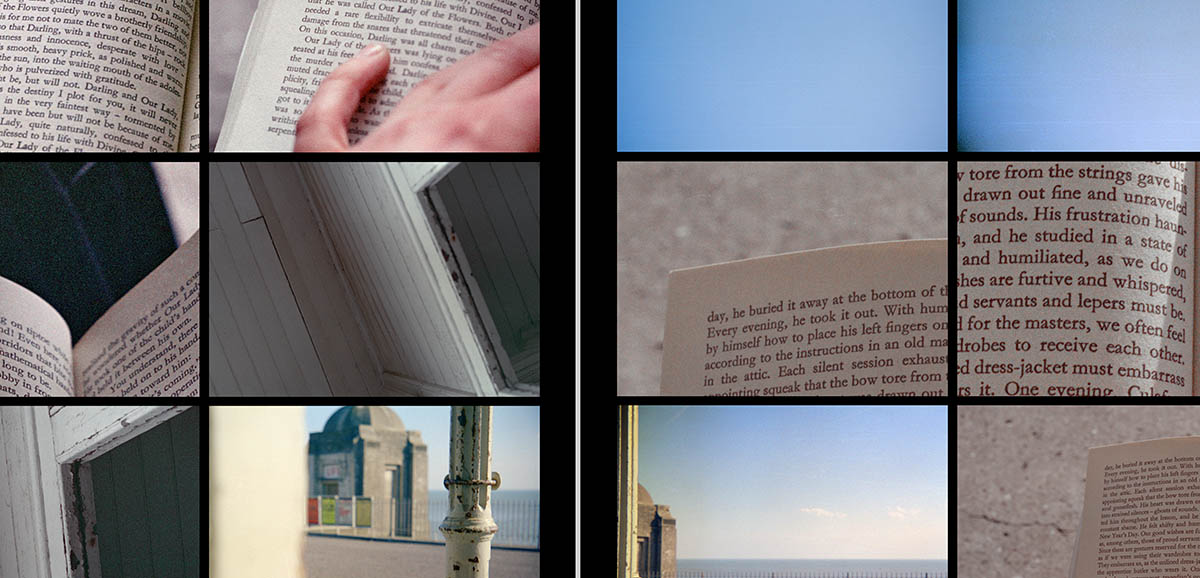
The Pleasured Text? (for the masters), detail.
2018, from negatives made March 1977.

The Pleasured Text? (for the masters), detail.
2018, from negatives made March 1977.
LdiF: What’s this? Is it new?
PFW: Yes, but from old original material. I’ve been looking through negatives from the 1970s and I came across a sequence I made on the Western Promenade in Ramsgate. I spent a lot of time there in my youth. Used to sit in the shelters and read and watch the atmosphere over the sea and the light change. I'd watch the world go by, well, what little of it that was around, especially in the winter. I found ten or twelve negatives where I had been reading Genet’s Our Lady of the Flowers. So I’d photographed the book in front of me and then waved the camera around, clicking without any thought, in the way I did in those days. I suppose I was struck by the contrast and the connection between the prose - intense, over the top, coloured up, very intentional, calculated to provoke a response, all that sexualised fantasy, with its religious intensity, all declaiming difference and promoting and mythologising the self - and these faded seaside facilities in the cold winter sunshine. This decaying genteel promenade where I was sitting reading and people walked their dogs and looked at the sea and breathed. It seemed to me, even then, to come from some lost past. But somehow, although he was alive and active at the time, Genet's writing seemed to come from the past as well, or to be responding with rage to some trauma. I think I could see a connection, and a gulf, a void, between the place - which also seemed to have suffered, be suffering, a deep trauma - and the contents of the book. Both seemed utterly defunct. I think the presumptions I sensed in these two cultural iterations, and my feeling of being powerless and not part of either world - not that I'd want to be because there was, you know, death in both - but it exposed and focussed a pervasive anxiety that was not just part of me but of the time...and not just that time or that state of cultures....
LdiF: I think that's the only time I've ever heard you talk of your book pieces in a way that's troubled by, grasping at, some sort of conventional meaning. When I've looked at them in the past they always seemed to be generating irony. Denying meaning in the very place in where we might look for it. What brought you to read Genet?
PFW: OK, well, perhaps we should scrub that last bit out then. Because I do think that fundamentally meaning is something that is brought to works of art, rather than to be found in them. That is the primary function of art, or the way it functions, to be a palimpsest. Perhaps primary's the wrong word, but what brought me to read Genet? You did I think. You had encouraged me to read Sartre, who was having a bit of a revival at the time, so I read the novels and Existentialism and Humanism[2], and I read about Saint Genet, so then I read The Thief's Journal and Our Lady of the Flowers. I think I was dubious about them both.
LdiF: You mean Jean Paul who had decided to define himself as the liberator of humanity and Jean Genie over whose beatification he presided?
PFW: Yes.
LdiF: You couldn't buy Sartre's notion that opposed his philosophy to essentialism? Or the notion of free will? Or that when we make ourselves we make all humankind?
PFW: I don't know, I never got a grasp of "existence precedes essence". I really liked Sartre's trenchant atheism but by then I'd already begun to have doubts about the existence, or at least the status, of the 'self', the 'I'. So, I've probably got it wrong - you tell me - but if the self...I think philosophers call it the subject?
LdiF: Yes, a thinking or feeling entity, the conscious mind, the ego...
PFW: If the existence of that, as an entity, was questionable then the notion that human beings are fully responsible for what they are, that they are free, that there is such a thing as 'free will' is also questionable. My feeling was that most of the monoliths of European thought are rooted in the idea that the 'I', the 'self', has some sort of unitary existence....
LdiF: So what are you? A hazy mass of functions and illusions you call 'I'? Something undefined and constantly in flux, like the sea or clouds?
PFW: Perhaps not undefined but, yes, I'd accept that rough description. If there is only process, if every 'thing' is flux, if there are only events, then the immortal soul and the distinct, independent, thinking, feeling acting subject are both impossible. So from fairly early on the notion of art as 'self expression' seemed absurd and I think I was drawn to photography because it seemed to offer the possibility of avoiding subjectivity.
LdiF: You're not exactly in tune with the zeitgeist are you? I noticed in your notes from the time, the ones you showed me earlier, that you'd written "existence is absent from the moment of exposure". Was that you grasping at something like the existentialists "existence precedes essence"?
PFW: I don't want to get bogged down in ancient philosophy, which existentialism now seems. I'll never be a philosopher, haven't got the brain. I try to make things, arrangements of images, that might have some purchase on my perception of fundamentals, sometimes things seem to make a sense I can't make sense of... but "existence is absent from the moment of exposure" ..perhaps I also meant "at the moment of exposure". I suppose, as we've discussed before, I was trying to make photographs where, at the moment the shutter was clicked, there was no intention....
LdiF: You mean no direction of your mind towards what was being photographed?
PFW: Yes, I wanted to absent myself from that moment, to discover what was there. I also think that there is a way in which photographic images absent their apparent subject from existence, from corporeality, from time. I mean, because everything is flux, what you see in a photograph cannot exist...and, perhaps, never existed because the photograph is an analogue, it is something other, and records only its own response to existence, or to the light focussed by a lens. It doesn't record reality or any state of existence.
LdiF: We've moved away from the book photos, perhaps we can look a bit more at the actual works? You exhibited something like this, with pictures of books, a long time ago, I seem to remember. Back in the old days in Southampton, at the Bolderwood Gallery, at the University, where I did my one and only great performance piece. There were five or six panels on a wall, very gloomy colours like they had been photographed by the light of a low power bulb and just your hand coming into the picture, now and then. It all looked like it was under brown water, or seen through glass, or amber perhaps. I remember being rather perplexed, "Where's the narrative"? “Is this irony”? And then “no, it's paradox”. Can we try to go back to the beginning? How did you start doing the text works?

The Pleasured Text? (of the subject. So, too, slow motion).
1977 (original work now destroyed).
PFW: I've always had problems with doing what is expected. If something is the norm I have a tendency to want to deviate. I went to art school, did a painting degree, but only made photographs for my final show. I really did not want to, or perhaps was unable to, think of myself either as a painter or as a photographer or even as an artist. I certainly didn’t want to take photographs as photographs were taken by photographers.
LdiF: I suppose, if I was concerned about your condition, I might have thought you were leaning a little bit towards the autistic, but I thought you were just being a good modernist, you know, always questioning the form. But let's stick with the empirical. What was going through your head when you started exposing reels of film on random texts?
PFW: In the 1970s I always had a camera with me, a lot of the time I also had a book with me. So I would sit and read, look up and see the world going by and think, “this is a multiple narrative situation. The book is a sequence of events, what I can see when I look up is a sequence of events, I am a sequence of events......no hang on, the book is an overlaid and interleaved sequence of sequences of events, both actual and depicted or should I say physical and related or described, that don't have to be read, or experienced, in any particular order, or at all, maybe the world, me included is also like that. Perhaps vision interplays with memory and time to create this fiction that is called perception. We think we perceive objects but how can we when everything is always in a complex of movement and interrelation?" My head began to swim, I was on the point of a seizure. So, I decided that I could not carry on taking pictures that denied what I suspect you might call flux. The notion of the "decisive moment" always seemed imbecilic to me. I couldn't make photographs that...... I had to do something that slowed everything down, and yet allowed for an apprehension of complex interrelatedness, and the paradoxes of the text-in-a-context photographs seemed to do that. Does any of that make sense?
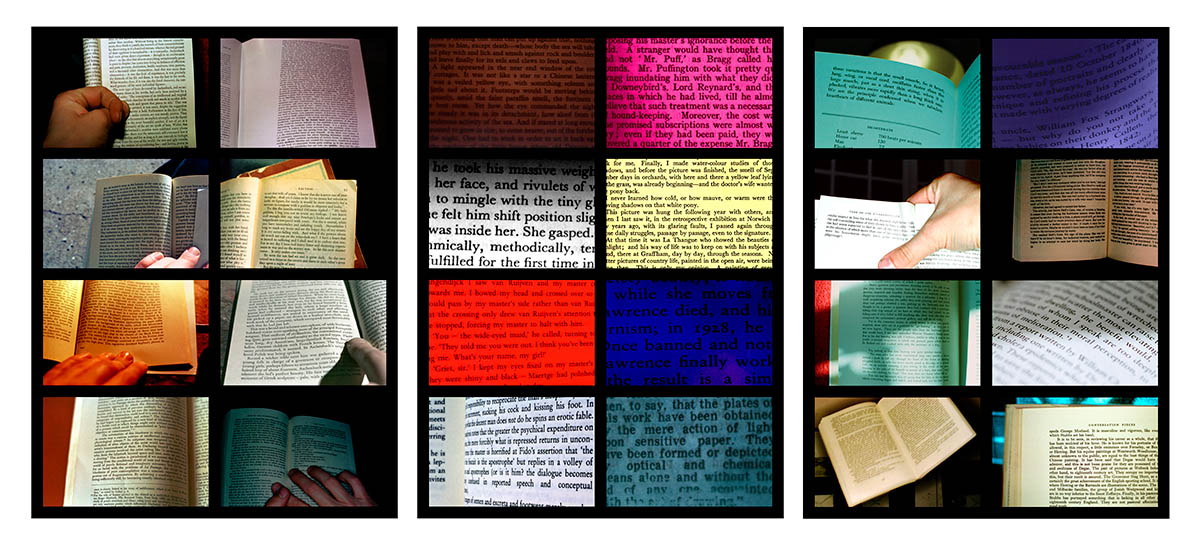
The Pleasured Text? (Puffington took it pretty).
1975-2003.
LdiF: Maybe. From quite early on you called these sets of images “Pleasured Texts”. Where did that come from?
PFW: It's Pleasured Texts with a question mark, and I'm afraid it's your old friend Barthes. He wrote two books that I have felt strongly about, his last, Camera Lucida[3], which was very influential in photographic circles and I thought was fundamentally wrong in most of the things it had to say about the photograph, photographers and time, and The Pleasure of the Text[5] which I read the year the translation was published and which I found immediately engaging.
LdiF: It's a difficult book.
PFW: For me it was a very difficult book. It starts with an epigraph in Latin – no translation offered - and in 1978, or whenever it was, even with access to a good library it was a day's work, if you knew no Latin, to find out what it meant. Then the first few lines refer to Bacon's simulator and someone called Monsieur Teste – who we have to imagine in reverse - so that's another major research project for an English ignoramus like me.
LdiF: You know Barthes lived with his mother for most of his life? That might have something to do with the Hobbes. “Fear and I were born twins” is, I think, a part translation of that epigraph[6].
PFW: Might also explain his view that the referent and the photograph were consubstantial.
LdiF: I don't think it's quite that. But The Pleasured Text?
PFW: OK, Barthes’ title was a good one, especially in the original French, and close to areas I think the work is partly about, so I was nodding in his direction. Pleasured, because the symbolism, but let's not get into Freud bollocks, perhaps the parallel of the open book and the readers fingers is inescapable. And a question mark because I was not making any statement. The work was asking what happens if/what does this mean/what is this? And, (I think this makes sense) the work questions relationships between the centres of sensual and cognitive pleasure. But then I don’t like the word question there, works of art don’t question, that’s art world cant. I was trying to make something that worked with, balanced, held in tension, I don’t know…those two sides of human experience: the intellect, understanding, logic, meaning , and then the other aspect: perceptual, sensory, even sensual, pleasure.
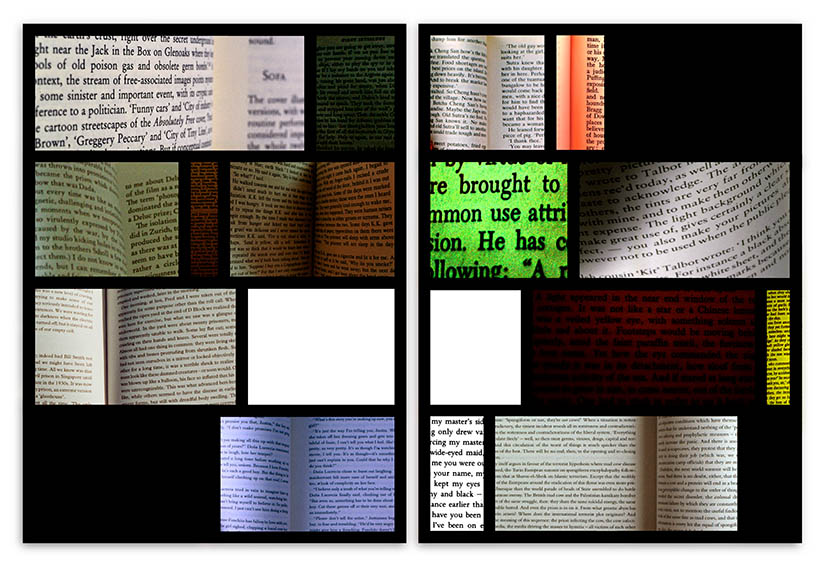
The Pleasured Text? (Kept my eyes and black).
1977-2003.
LdiF: The viewer's response could be questioning, I suppose, and maybe this unusual juxtaposition and arrangement of images invites questioning. But, I think what you say about sensual and cognitive pleasure takes us straight to Paul Valéry and Monsieur Teste, and/or his reverse.
PFW: You have me there, I never followed it up.
LdiF: Well, it's a long time since I read it, but Monsieur Teste gets his pleasure, or his existence, from the workings of his mind: he can't have an experience or a sensation, or a life, but can only think about those things. He can’t experience anything because he is always examining it intellectually as it happens . There is a wonderful passage in the book where Valéry describes “A Walk with Monsieur Teste” and the narrator, the Valéry voice, describes the scene on the street as they walk and everything is all poetic description and allusion, it’s a beautiful passage, reminds me of some of your ‘street’ photos, and the unstated implication is that Teste doesn’t see any of it because he’s analysing, measuring and comparing and judging.
PFW: Yes, and one of the things I got from Barthes - well I didn’t get it from him I kind of recognised that he had it as well - was that you could, that part of the pleasure of reading, one of the pleasures of reading, came independently of any understanding of the literal meaning of the text. About the same time I read Proust’s On Reading[7], which covers similar ground….
LdiF: There’s also a great chapter, if I remember rightly, when Madame Teste, who is I guess something like what Barthes calls “Monsieur Teste in reverse” in that she is all sensibility and immediacy, describes reading a letter to M. Teste and not understanding a word of it. But she says she really enjoys the beauty of the words. I think when you and I first met and saw a lot of each other, back in Winchester, I recognised a lot of M. Teste in you and what I liked was that I could see old Emilie Teste in there, fighting her corner, as well.
PFW: Aren’t there those two sides in everyone?
LdiF: My guess is that it becomes more pronounced, one side or the other or the tension, or lack of tension, between the two, in anyone trying to do anything creative. But enough of Teste. You were thinking by making as artists, sorry, as photographers or whatever, do. And you made some things that a book by a French academic later seemed to have some interesting accordances with. Is that right?
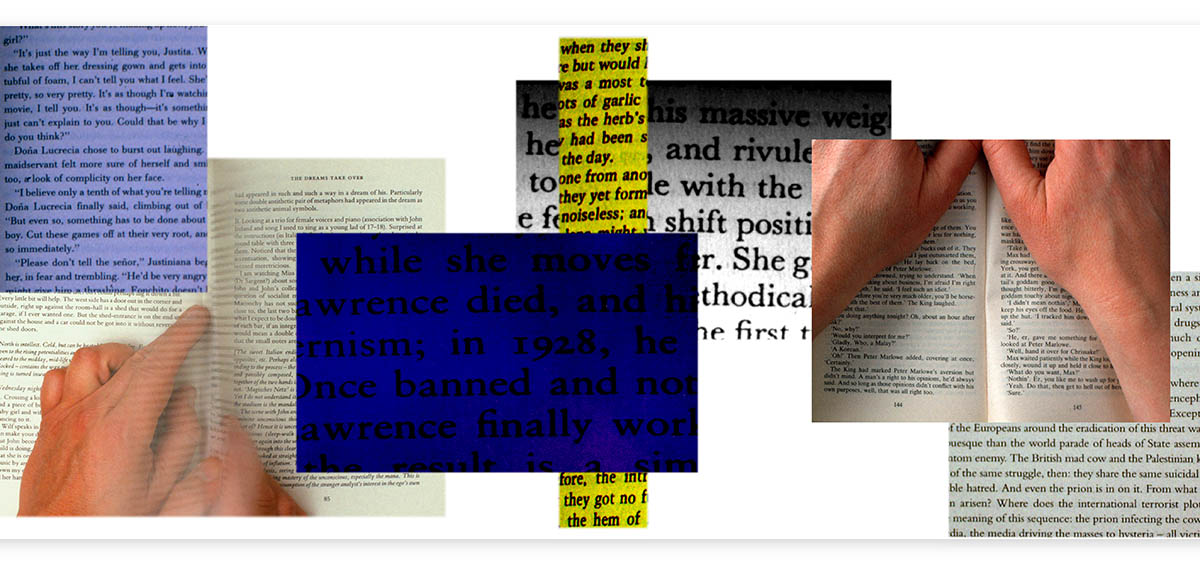
The Pleasured Text? (Voices and piano (association[...])), (detail).
2015.
PFW: Yes. I don't know now if it's in The Pleasure of the Text but what I was thinking about was the randomness of meaning, the contingent nature of meaning, the unintended , or unprescribable, multi-layered, unfixed nature of meaning. And I recognised through Barthes, or he helped me articulate in my own mind, that I had been trying to bang together the impetus to make sense and meaning, to 'read' a work of art, and the impetus to get pleasure, sensory, heightened, climactic even, sensual pleasure that has a relationship, a connection with sexual pleasure, what Barthes calls, the French I think call, jouissance.
LdiF: Some of the dominant forces in the cultural world absolutely foreground meaning and a reading of, say, a painting, or even music, as a text which can be 'got'.
PFW: I suppose the orthodoxy of that way of positioning works of art was something I was trying to frustrate. As I said “question the form” even if it is the supposed form of alleged communication, or that the primary purpose of art was to communicate something within the work, that the work expresses.
LdiF: Yes, if you ask the questions - "Why is this here?" and "what is the context in which this appears?" - of any work of art that you encounter you may get a more productive answer than by trying to solve the riddle of "what does this mean?".
PFW: I wanted to shift the balance, not just in this sequence of works but in others as well, to create some sort of disjuncture and I found that by taking meaningful text and rendering it (in its own terms) unmeaningful what I seemed...
LdiF: Hang on, but you don't make the texts meaningless. It seems to me that it is important that every word still has meaning both in itself and in the depicted text. What you are doing is disrupting the narrative of the text...Maybe, displacing the meaning of words?
PFW: To create a kind of psychological release, a sense of freedom from meaning. I was trying to make something that functioned at multiple levels of significance, one of which was the absence of meaning.
LdiF: Rhilopia: a word that is in no dictionary, so it is what it means. I've never found another word like it. Maybe your words, your photographed texts, are?
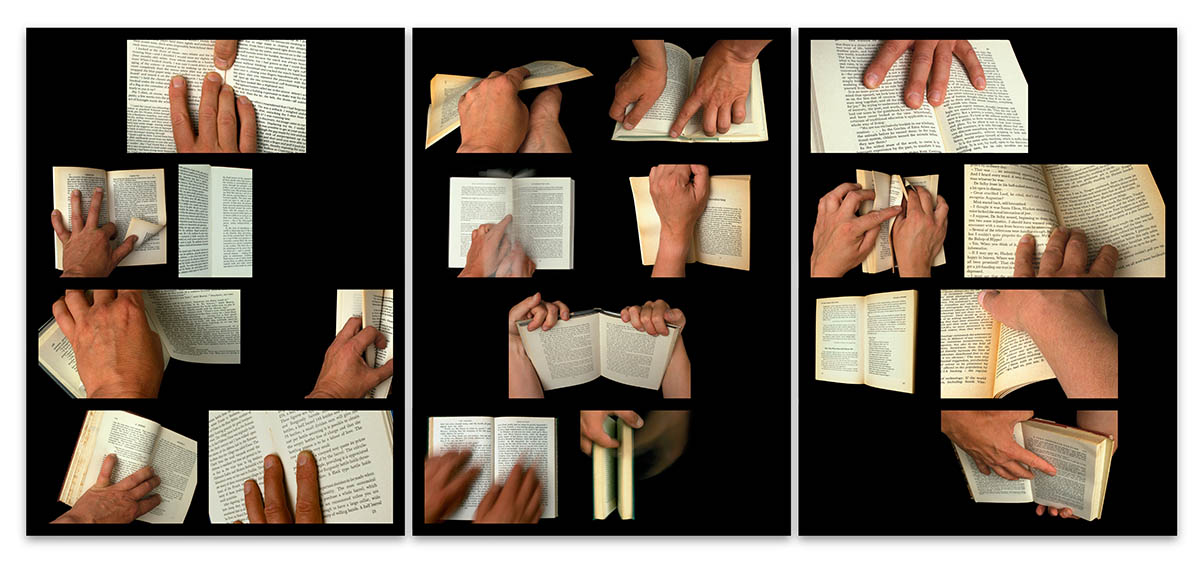
The Pleasured Text? Until the clouds is bursted.
2003.
PFW: No. Yes, but you're right, all the words, when you can read them, still have a meaning. Perhaps their meaning is diffused, liberated, set adrift? I think, one reason art is compelling - and I’d include all art from the most fatuous to the most apparently 'meaningfull' - is that it releases us from the imperative of meaning. Daily life is threaded through with meaning that has to be addressed (you know - traffic lights, bank statements, the child crying); in art, all art, meaning is not simple or fixed and response is always optional.
LdiF: It's a kind of freedom, perhaps. Some might say that if you go one step beyond ambiguity you arrive at chaos, which is not a good thing, it restricts, impedes, liberty...
PFW: Yes, but nothing can be unambiguous, except the most basic and simple facts in the most basic and simple situations, possibly. There's a very limited range of questions which can be properly answered either Yes or No. If something is meant to mean only one thing it should be unequivocal, but no photograph can ever be, nothing made can ever be. I suppose everything is ambiguous, or can be made to be, as Duchamp’s snow shovel with its feeble inscription pointed out, so what might lead to mental chaos, to the diffusion of thought, understandings, is unacknowledged ambiguity. That’s why I reject the concept touted as 'documentary' photography because it always contains a collusion with deception. That's not to say I don't admire, respect, believe in one way or another, all those news photos and historic photos. They do a job, but like words they don't in themselves contain anything that can be called fact. Facts are made from many elements, there's no simple fact. What I wanted to do was make it so the viewer could make two or more, possibly opposing or conflicting, apprehensions of the work coexist or cancel themselves out. So meaning and the meaningless might be in a state of dynamic balance.
LdiF: So they might just find pleasure in a space between meanings, which has no meaning or significance in itself…?
PFW: Yes.
LdiF: What about the ones with the hands (your hands?) in every image? They are like a documented performance..
PFW: I hope they are more than that. I think I was trying to open up a grasp of the reciprocal physicality of both making a photograph and engaging with any media, not just a book and a picture. If these things are hung on a wall you walk up to them, bend your back and head to look closely at the details, stand back, do that head to one side "I'm thinking about this" pose. Then you walk on. I think we forget that making a work of art involves a lot of physical activity. When I taught photography I used to try to get the students to use their bodies. "You can't just stand there going click, click, click. Come on it's a dance - the subject is your partner - you've got to get round it, lift it up (by getting down), spin it (by running round it), get right down under it (lie on the floor), leap above it (get on that chair), move away, come back"
LdiF: To me, there seems to be a connection between the spine of the book, this armature around which the narrative and the physical object of the book spins, and something which must be the spine of the photographer, or is it the reader, or is it the viewer of your work?
PFW: Yes. But remember the unitary self which might be any of those three has existence only in illusion: that's what the work may suggest....
LdiF: In these the books are actually photographed much more as objects in themselves, even the formal black grid you use has spread to fill the background, whereas in most of the others the book is photographed in a context, or the text expands to fill the picture plane. I mean in those it's photo'd close up, and often appears to have been subjected to some sort of manipulation like colouring or distorting in some way. These ones show the book more as an object, not a text?
PFW: Well, you can see, and therefore photograph an object, but it's only a phenomenon, an appearance...and, of course, so is the photograph.
LdiF: There are only events, and what might appear to us as an object is just the phenomenal nexus of a continuum of events?
PFW: That sounds right to me and, as we discussed earlier, we are as well.....
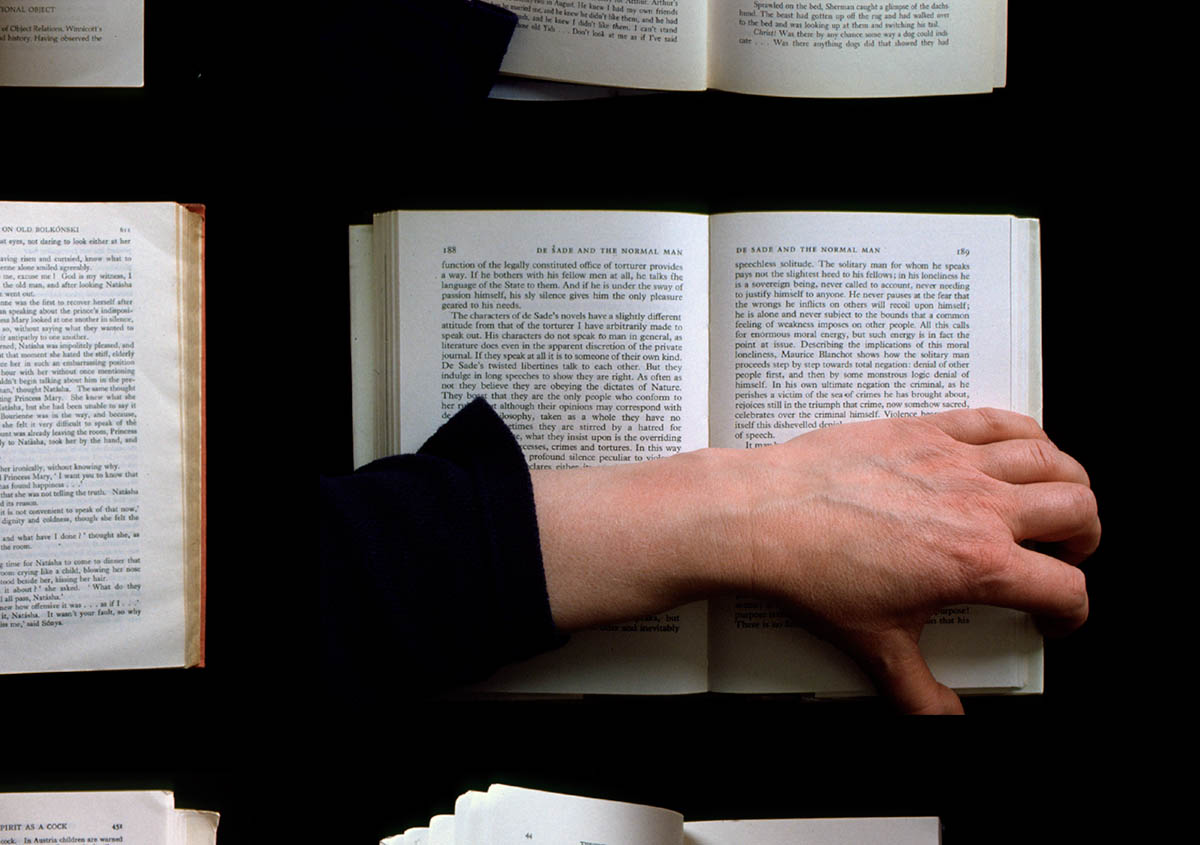
The Pleasured Text? A sun baked rose below (detail).
2003.
Images and texts by P.F.WHITE (Peter Frankland White). ACTIVE: 196Os to the present. LOCATION: Europe (United Kingdom). SUBJECTS: vision, perception, location, time(s), class, power, rhilopia. STYLE: exploratory, aggregative, aleatory, attentive, punctum averse.
All material (except where otherwise acknowledged) is © Peter Frankland White, , and may not be reproduced in any form without written consent. See: Notes on Rights, Ethics, Privacy and Consent. Page design by Allpicture.